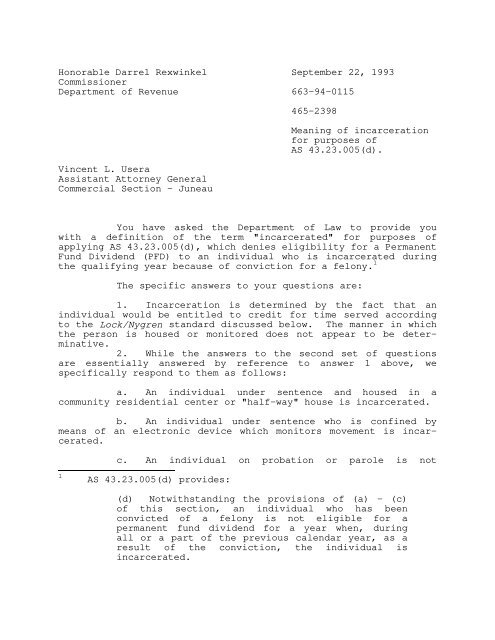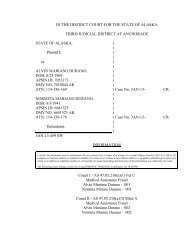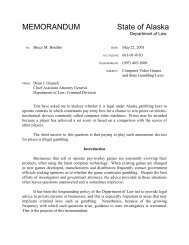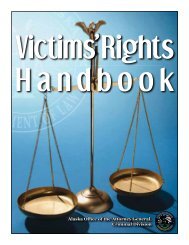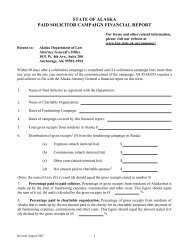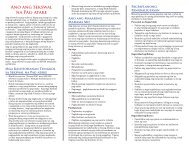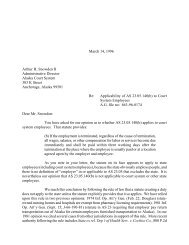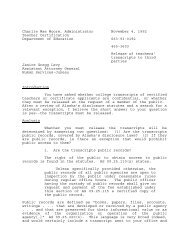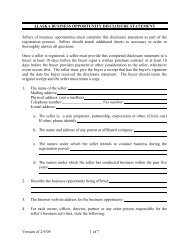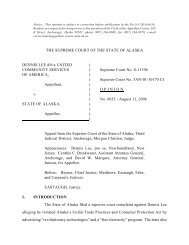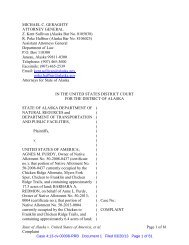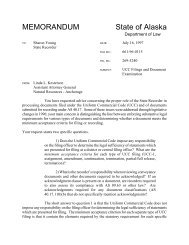Meaning of incarceration - Alaska Department of Law
Meaning of incarceration - Alaska Department of Law
Meaning of incarceration - Alaska Department of Law
Create successful ePaper yourself
Turn your PDF publications into a flip-book with our unique Google optimized e-Paper software.
Honorable Darrel Rexwinkel September 22, 1993<br />
Commissioner<br />
<strong>Department</strong> <strong>of</strong> Revenue 663-94-0115<br />
Vincent L. Usera<br />
Assistant Attorney General<br />
Commercial Section - Juneau<br />
465-2398<br />
<strong>Meaning</strong> <strong>of</strong> <strong>incarceration</strong><br />
for purposes <strong>of</strong><br />
AS 43.23.005(d).<br />
You have asked the <strong>Department</strong> <strong>of</strong> <strong>Law</strong> to provide you<br />
with a definition <strong>of</strong> the term "incarcerated" for purposes <strong>of</strong><br />
applying AS 43.23.005(d), which denies eligibility for a Permanent<br />
Fund Dividend (PFD) to an individual who is incarcerated during<br />
the qualifying year because <strong>of</strong> conviction for a felony. 1<br />
The specific answers to your questions are:<br />
1. Incarceration is determined by the fact that an<br />
individual would be entitled to credit for time served according<br />
to the Lock/Nygren standard discussed below. The manner in which<br />
the person is housed or monitored does not appear to be determinative.<br />
2. While the answers to the second set <strong>of</strong> questions<br />
are essentially answered by reference to answer 1 above, we<br />
specifically respond to them as follows:<br />
a. An individual under sentence and housed in a<br />
community residential center or "half-way" house is incarcerated.<br />
b. An individual under sentence who is confined by<br />
means <strong>of</strong> an electronic device which monitors movement is incarcerated.<br />
c. An individual on probation or parole is not<br />
1<br />
AS 43.23.005(d) provides:<br />
(d) Notwithstanding the provisions <strong>of</strong> (a) - (c)<br />
<strong>of</strong> this section, an individual who has been<br />
convicted <strong>of</strong> a felony is not eligible for a<br />
permanent fund dividend for a year when, during<br />
all or a part <strong>of</strong> the previous calendar year, as a<br />
result <strong>of</strong> the conviction, the individual is<br />
incarcerated.
Honorable Darrel Rexwinkel September 22, 1993<br />
Commissioner, Dept. <strong>of</strong> Rev. Page 2<br />
663-94-0115<br />
incarcerated, even if required to report daily to a probation<br />
<strong>of</strong>ficer.<br />
Our analysis follows:<br />
Generally, we believe "incarcerated" to apply to a<br />
person who is confined in a facility or environment that is<br />
intended to restrain the person's movement and freedom, and<br />
includes prisons, jails, and other penal institutions. Penal<br />
institutions can include hospital, medical, or treatment<br />
facilities which serve persons who would otherwise be confined in<br />
prison, but for the condition for which they are sent to the<br />
hospital or treatment facility. We also believe persons who are<br />
restrained in their movements but not confined to a penal<br />
institution may be considered to be incarcerated. Included in<br />
this latter category would be a person who is confined to an<br />
otherwise nonpenal setting - such as his or her living quarters <br />
and monitored by some sort <strong>of</strong> electronic device.<br />
Legislative history provides no indication <strong>of</strong> the<br />
legislature's intent with respect to the definition <strong>of</strong> <strong>incarceration</strong><br />
for purposes <strong>of</strong> AS 43.23.005(d). We believe, however,<br />
that, given the purpose <strong>of</strong> the statute as making money available<br />
to the Violent Crimes Compensation Board, our interpretation <strong>of</strong><br />
incarcerated is in keeping with an implied legislative intent.<br />
There is nothing either in statute, regulations, 2 dictionary<br />
definitions, 3 nor case law that is completely determinative, and<br />
2<br />
Various custody classifications for prisoners are contained<br />
in regulations <strong>of</strong> the <strong>Department</strong> <strong>of</strong> Corrections at 22 AAC 05.271<br />
and range from "Community Custody" in which the prisoner is under<br />
the least restrictive custody to "Maximum Custody" in which the<br />
prisoner's movement is highly restricted, and, even while within<br />
the facility, requires two escorts and physical restraints.<br />
"Community Custody" includes work releases, furlough, and hospital<br />
treatment while the individual is under sentence.<br />
These classifications comport conceptually with the<br />
Lock/Nygren standard presented below.<br />
3<br />
Dictionary definitions <strong>of</strong> <strong>incarceration</strong> provide no real help<br />
in this determination. Among those definitions are: "Incarceration:<br />
a confining or state <strong>of</strong> being confined: IMPRISONMENT."<br />
Webster's Third International Dictionary, Unabridged 1141 (1966).<br />
"Incarceration: Imprisonment; confinement in a jail or penitentiary.<br />
See Imprisonment." Black's <strong>Law</strong> Dictionary 685 (5th ed.<br />
1979). Both definitions refer to imprisonment, which is defined<br />
as:
Honorable Darrel Rexwinkel September 22, 1993<br />
Commissioner, Dept. <strong>of</strong> Rev. Page 3<br />
663-94-0115<br />
we believe reliance on common sense and implications derived from<br />
case law is warranted and provides a sound conclusion.<br />
Under <strong>Alaska</strong> case law, a person whose freedom <strong>of</strong><br />
movement is substantially restricted because <strong>of</strong> court-ordered<br />
confinement to a residential rehabilitation program is considered<br />
to be in custody for purposes <strong>of</strong> crediting time spent in custody<br />
towards service <strong>of</strong> his sentence. Lock v. State, 609 P.2d 539<br />
(<strong>Alaska</strong> 1980). The court provided some helpful amplification <strong>of</strong><br />
the meaning <strong>of</strong> "custody," which, while not necessarily precisely<br />
the same as <strong>incarceration</strong>, gives considerable guidance in<br />
development <strong>of</strong> our interpretation. The court said:<br />
We think that under certain circumstances the<br />
restraints imposed as conditions <strong>of</strong> probation may<br />
be so substantial that the defendant is, in legal<br />
effect, "in custody" although on probation.<br />
Confinement need not be penal in nature to be<br />
custodial. McNeil v. Director <strong>of</strong> Patuxent<br />
Institution, 407 U.S. 245, 92 S. Ct. 2083, 32 L.<br />
Ed. 2d 719 (1972). Nor need the defendant be<br />
confined to a prison or jail in order to be "in<br />
custody" within the meaning <strong>of</strong> AS 11.05.040 [the<br />
statute mandating credit for time spent in<br />
custody, now contained in AS 12.55.025].<br />
Custodial confinement takes many forms and has<br />
The act <strong>of</strong> putting or confining a man in prison.<br />
The restraint <strong>of</strong> a man's personal liberty;<br />
coercion exercised upon a person to prevent the<br />
free exercise <strong>of</strong> his powers <strong>of</strong> locomotion. It is<br />
not a necessary part <strong>of</strong> the definition that the<br />
confinement should be in a place usually<br />
appropriated to that purpose; it may be in a<br />
locality used only for the specific occasion; or<br />
it may take place without the actual application<br />
<strong>of</strong> any physical agencies <strong>of</strong> restraint (such as<br />
locks or bars), as by verbal compulsion and the<br />
display <strong>of</strong> available force. Every confinement <strong>of</strong><br />
the person is an "imprisonment," whether it be in<br />
a prison, or in a private house, or even by<br />
forcibly detaining one in the public streets. Any<br />
unlawful exercise or show <strong>of</strong> force by which person<br />
is compelled to remain where he does not wish to<br />
be.<br />
Black's <strong>Law</strong> Dictionary 681 (5th ed. 1979) (citation omitted).
Honorable Darrel Rexwinkel September 22, 1993<br />
Commissioner, Dept. <strong>of</strong> Rev. Page 4<br />
663-94-0115<br />
been interpreted to include time spent in a mental<br />
hospital, a juvenile detention center, a<br />
diagnostic center, a hospital, a halfway house,<br />
and a hotel room.<br />
Lock v. State, 609 P.2d 539, 543-44 (<strong>Alaska</strong> 1980) (footnotes<br />
omitted). See also Nygren v. State, 658 P.2d 141, 146 (<strong>Alaska</strong><br />
App. 1983), in which the determinant is whether "'substantial<br />
restrictions on one's freedom <strong>of</strong> movement and behavior' have been<br />
imposed, so as to require credit for time served under Lock"<br />
(emphasis added).<br />
By contrast, a person in third-party custody, however,<br />
is not in such a custodial setting as to warrant credit for such<br />
time against his sentence. Ackermann v. State, 716 P.2d 5 (<strong>Alaska</strong><br />
App. 1986). 4 Probation and <strong>incarceration</strong> are, under ordinary circumstances,<br />
mutually exclusive. See, e.g., State v. Jackson, 776<br />
P.2d 320 (<strong>Alaska</strong> App. 1989) (making the distinction between a<br />
probationary sentence and <strong>incarceration</strong> for purposes <strong>of</strong> propriety<br />
<strong>of</strong> sentence). Parole and <strong>incarceration</strong> are not the same, even<br />
though the parolee must report frequently to an <strong>of</strong>ficer charged<br />
with his or her supervision. See, e.g., Jackson v. State, 616<br />
P.2d 23 (<strong>Alaska</strong> 1980); Walters v. State, 798 P.2d 357 (<strong>Alaska</strong> App.<br />
1990).<br />
Other case law provides some additional insights in<br />
harmony with those above. A situation in which a person is under<br />
"community confinement" or home detention, i.e., not within an<br />
institution, but whose movement is restricted, has been found to<br />
be "imprisoned," and, therefore, incarcerated. United States v.<br />
Strozier, 940 F.2d 985, 988 (6th Cir. 1991). This is in concert<br />
with the "Community Custody" status described by 22 AAC<br />
05.271(b)(1). However, a person given a suspended imposition <strong>of</strong><br />
sentence and period <strong>of</strong> probation was found not to be under<br />
conditions <strong>of</strong> <strong>incarceration</strong> in Petition <strong>of</strong> Sewell, 474 P.2d 146,<br />
147 (Mont. 1970).<br />
Thus, the common determinant in <strong>Alaska</strong> case law is<br />
exemplified by the Lock and Nygren holdings above. That is, if<br />
the individual is subjected to such restriction and limitation<br />
that he or she would be entitled to credit for time served while<br />
in that condition, he or she is incarcerated. This comports with<br />
4<br />
"We are satisfied that a person in third-party custody who<br />
has the freedom to move about the community, limited only by his<br />
custodian's accompaniment, and one who is confined to a fishing<br />
boat while it is at sea is not entitled to credit for time spent<br />
on pretrial release." 716 P.2d at 6 (emphasis added).
Honorable Darrel Rexwinkel September 22, 1993<br />
Commissioner, Dept. <strong>of</strong> Rev. Page 5<br />
663-94-0115<br />
holdings from other jurisdictions and with the definitions and<br />
regulations considered above. Accordingly, we believe the proper<br />
standard to apply in making the determination <strong>of</strong> whether an<br />
individual is incarcerated for these purposes is whether the<br />
individual, in the status in question, would be entitled to credit<br />
for time served against whatever sentence might be imposed.<br />
We hope this responds to your question. Should you<br />
have need <strong>of</strong> further clarification, please do not hesitate to<br />
contact us.<br />
VLU:prm


